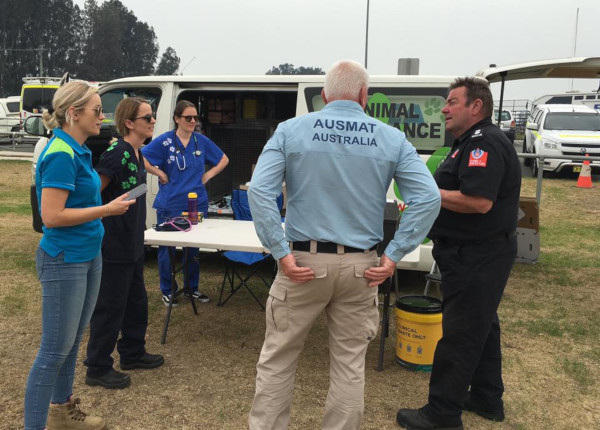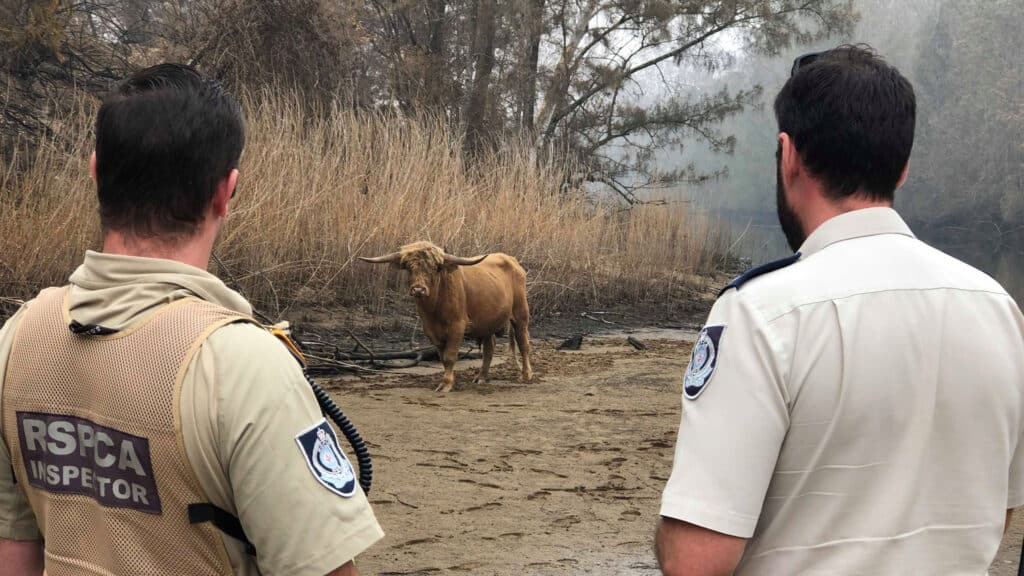Home > Information and Advice > Caring for Animals > Pet Hazards > Bushfires and House Fires
Whether your pets remain safe at home or are evacuating with you, you need to do your best to ensure their safety in the event of an emergency.
Know who to contact during a fire and create pet emergency plan to greatly increase the likelihood of evacuating your pets to safety. Having an emergency kit prepared will greatly increase the likelihood of safely evacuating your animals during crisis situations.

As the leading animal welfare organisation in NSW, we’re responsible for keeping both our communities and animal companions safe, especially during emergency situations such as bushfires, droughts, and floods. In addition to directly supporting people, wildlife, and pets, we also educate pet carers about emergency preparedness to proactively minimise risk and protect animals’ lives.


RSPCA NSW is seeking compassionate and dedicated volunteers to join our Emergency Response Team and play a critical role in supporting communities affected by bushfires and other emergencies. From distributing supplies to establishing animal friendly evacuation centres, your primary responsibilities will vary depending on your role. No matter your contribution, you’ll be making a positive impact in the lives of people and pets.

RSPCA NSW rehomes a range of different animals, from dogs, cats, and birds to horses, rabbits, and sheep! We believe that all creatures, great and small, can bring joy to our families and homes. Begin your adoption journey today and make an adorable lifelong friend!
By providing temporary homes for our animals, we can ensure they get the care they need until they are ready to be adopted. Join our network of foster carers for an incredibly rewarding experience; with your help, we can change the lives of some of the state’s most vulnerable animals.
We rely on our generous supporters to continue assisting the thousands of animals turning to RSPCA NSW for help. No matter how small your contribution, every gift makes a lifesaving difference for animals in need.
By raising funds and lending a hand to communities and their pets, our volunteers play a pivotal role in our work throughout NSW. If you have a genuine concern for animals and enjoy meeting like-minded people, consider becoming an RSPCA NSW volunteer today!
In NSW, the Department of Primary Industries (DPI) are the primary agency for animal welfare during any emergency. However, they often share and delegate their responsibilities to RSPCA NSW or Animal Welfare League (AWL).
As the leading animal welfare organisation in NSW, we’re committed to helping both people and animals during emergency situations. Our Emergency Response Team is central to this mission, as our highly trained team helps ensure the safety of people and pets in fire-affected areas. RSPCA NSW also has a strong relationship with NSW State Emergency Services, meaning we’re often called to assist wherever animals are in need.
Having an emergency kit prepared will greatly increase the likelihood of safely evacuating your animals during crisis situations. Your emergency kit should include any items that will help you transport and care for your animal should the need to evacuate arise. This includes:
Evacuation can present some unique challenges for larger animals. That’s why, when preparing an emergency kit for evacuating horses and livestock animal, it’s important to be more mindful of the specialised care and transportation your animal companions will require during the evacuation process. Your horse and livestock animal emergency kit should include:
During emergency situations, access to veterinary care may be severely limited. That’s why preparing an animal first aid kit to accompany your evacuation kit is essential to ensuring you’re ready for any injuries or health emergencies that may arise.
Please note that horses and livestock animals may require additional items to be adequately treated in emergency situations. Remember to prepare any necessary supplies for large and farm animal care when preparing a first aid kit for your equine and livestock animal companions. This includes:
To ensure your animals are ready to be transported in emergency situations, make sure that you’ve adequately prepared both your animal companions and travelling equipment. Regularly inspect your float or trailer to ensure they are in safe working order. Additionally, you may also practice travelling with your animals, including short trips to help them get comfortable with being with you on the road. Routinely practice loading and unloading your animals to reduce stress and build familiarity with the procedure. For livestock animals, regularly move them in and out of safe areas to help them become accustomed to the route and environment.
If you must leave your animals behind, ensure they’re free to find food and safety without your supervision. Follow these steps to prepare your animals if you need to leave them behind:
It’s easy to feel helpless when trying to assist native wildlife animals during floods or fires, but there are many steps you can take – both in your backyard and local community – to support wildlife animals during emergency situations.
Legally, civilians and volunteers are unable to enter active bushfire zones, but organisations like RSPCA NSW and the Animal Welfare League (AWL) possess the training and equipment required to enter these zones during an active emergency. If you find an injured native animal, please contact us on 1300 278 3589 so we can try to help this animal. Alternatively, you can also contact NSW State Emergency Services, the AWL, the closest police station, or your nearest wildlife rescue organisation.
You can also make a difference for native animals outside of emergency events by creating safe and thriving ecosystems for wildlife to enjoy.
We promise to uphold the highest ethical standards. Your personal information has never been, and never will be sold or traded to other charities. This is our promise to you.



We acknowledge the Traditional Owners of the lands on which we live and work. We recognise and respect the enduring relationship they have with their lands and waterways, and particularly acknowledge the vital role animals have played in Indigenous life, stories and culture for tens of thousands of years.
The RSPCA is an independent, community-based charity providing animal care and protection services across the country.
This site is protected by reCAPTCHA and the Google Privacy Policy and Terms of Service apply.
The RSPCA is an independent, community-based charity providing animal care and protection services across the country.


This site is protected by reCAPTCHA and the Google Privacy Policy and Terms of Service apply.